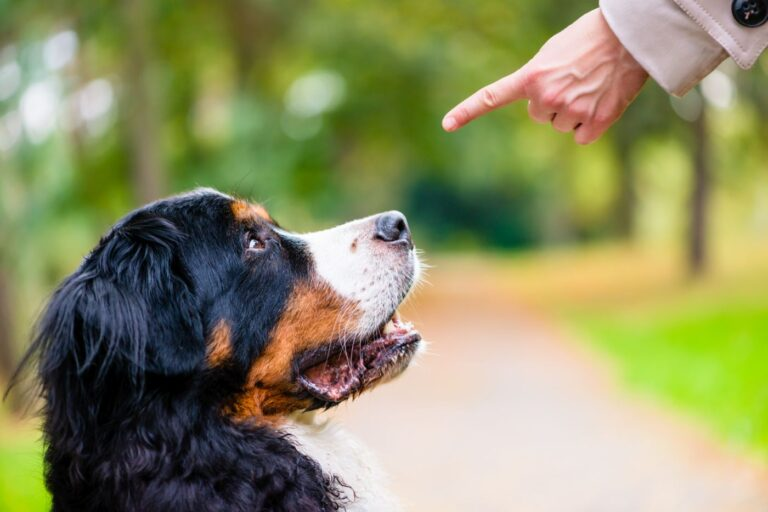Clear communication is essential to allow your dog to understand what you are asking of him.
If your furry friend doesn’t listen to you, it’s not just exhausting: it can also become dangerous. Because stopping a dog who only follows his instincts and ignores commands is an almost impossible task. But why do some dogs refuse to obey? How can you avoid training mistakes and get your dog to listen? Let’s find out what you can do if your dog is disobedient.
Summary
- Dogs like clear rules
- Why is my dog disobedient?
- What can I do if my dog doesn’t listen to me?
- Is your dog disobedient? Work on your timing!
- The most important rule: be consistent
- Can you train a dog to obey?
- How can I get my dog to obey me?
- Obedience on a leash
- Bottom line: The key to success is in your hands
1- Dogs like clear rules
Let’s start with a key concept: if your furry friend doesn’t listen to you, it doesn’t depend on his strong need for freedom . It’s clear that our furry friends also like to feel free, like when they can run in a meadow without theleash , when they play with other furry friends or walk on the shoreline of abeach for dogs , free to enjoy the sea and the wind.
But ultimately dogs are pack animals, who love and need rules in their everyday lives. They want to refer to their pack leader and feel they can trust him.
Disobedience is a source of great stress
If your furry friend barks, growls and snarls during your walks together,shows his teeth as soon as he meets another dog, usually not because he likes to intimidate others. Rather, he feels obligated to protect you.
In practice, think that without him you would not be able to handle the situation . This subjects not only you but also your furry friend to enormous stress.
Dogs need a boss, a leader who shows them the way with love but also with coherence , on whose judgment they feel they can always rely. Even theDog breeds that are considered difficult to train willingly listen to a competent person , as soon as they realize that this is the easiest way for them.
[blockquote align=”none” author=”– Golda Meir“]“The dog that trots about finds a bone.”[/blockquote]
Always have a reward available
Dogs are opportunists . They are more likely to engage in behavior that is worthwhile, from their perspective, than one that simply causes them stress. Especially if there is a reward involved! That’s why there must be a reason why your dog continues to behave in a way that does not bring him any benefit and actually causes him negative consequences.
READ MORE ON UNDERSTANDING YOUR DOG
2- Why is my dog disobedient?
dog. As hard as it may be to accept, the reason for his disobedience lies solely in your lack of training , or ina wrong education .
This does not mean that you should get lost in guilt or discouraged: on the contrary! It is clear that you have always wanted only the best for your furry friend and therefore you have made some mistakes due to inexperience or simply lack of time. But now the time has come to remedy this and work on abetter relationship between you and your dog .
Disobedient Dog: Here’s The Main Reason
To avoid making further mistakes with your furry friend, it is important to know where the past mistakes lie. One of the most common reasons why dogs do not obey their human’s commands is simply a communication problem . Thedog does not understand commands because he does not perceive them as requests.
Disobedient Dog: Here’s The Main Reason
To avoid making further mistakes with your furry friend, it is important to know where the past mistakes lie. One of the most common reasons why dogs do not obey their human’s commands is simply a communication problem . Thedog does not understand commands because he does not perceive them as requests.
What to do if your dog doesn’t come back when you call him
When we interact with our furry friends, we must absolutely avoid unclear, mumbled or contradictory commands . Also paying attention to the lack of correspondence between body language and tone of voice.
Dogs are experts at reading facial expressions and can quickly recognize their human’s mood . It doesn’t matter how friendly you call him with “Hey!”. If your furry friend notices that you’re upset, for example by fidgeting with your foot or twitching the leash, he probably won’t want to come to you. And who wants to run into trouble?
Bottom line: The key to success is in your hands
At this point, all you have to do is find out which training method is best for you and your furry friend. AA capable and experienced dog trainer will be able to give you other suggestions and teach you some tricks to improve your dog’s obedience.
It’s never too late to teach your furry friend to listen to you and to listen to you. Success depends essentially on you. On your patience , consistency and, last but not least, on the time you are willing to dedicate to your dog and your training.
All that remains for us to do is wish you and your furry friend many years of harmonious and peaceful coexistence!
Why is my dog disobedient?
So, if your dog ignores your “Sit!”, “Keep it!” and “Let’s go!”, it’s not because he’s a stubborn dog. As hard as it may be to accept, the reason for his disobedience lies solely in your lack of training , or ina wrong education .
This does not mean that you should get lost in guilt or discouraged: on the contrary! It is clear that you have always wanted only the best for your furry friend and therefore you have made some mistakes due to inexperience or simply lack of time. But now the time has come to remedy this and work on abetter relationship between you and your dog .
Disobedient Dog: Here’s The Main Reason
To avoid making further mistakes with your furry friend, it is important to know where the past mistakes lie. One of the most common reasons why dogs do not obey their human’s commands is simply a communication problem . Thedog does not understand commands because he does not perceive them as requests.
What to do if your dog doesn’t come back when you call him
When we interact with our furry friends, we must absolutely avoid unclear, mumbled or contradictory commands . Also paying attention to the lack of correspondence between body language and tone of voice.
Dogs are experts at reading facial expressions and can quickly recognize their human’s mood . It doesn’t matter how friendly you call him with “Hey!”. If your furry friend notices that you’re upset, for example by fidgeting with your foot or twitching the leash, he probably won’t want to come to you. And who wants to run into trouble?
What can I do if my dog doesn't listen to me?
Just as problematic as confusing commands are commands that are repeated over and over again . It is important that your dog responds to a command the first time! It is tiring not only for you but also for him if you have to repeat it over and over. So, one thing to do is to avoid repeating a command a thousand times.
The problem of lack of authority
If you have to say “Sit!” to your dog six times before he does it, and when he finally does you reward him, you are undermining your own authority. It is the equivalent of telling him that he does not have to listen to everything you say right away.
Let’s take another example on the topic of lack of authority.
You want your dog to wait for you in front of the supermarket and then you tell him “Stay!”, only you do it so many times that eventually he will think he only has to sit as long as you repeat the command. The result of this misunderstanding will be that, once you enter the store, not being able to repeat the umpteenth “Stay!”, your dog will jump up and try to reach you.
Is your dog disobedient? Work on your timing!
Another element that makes it difficult for your furry friend to obey your commands is if they come at the wrong time . A dog that isdoing his business he cannot execute the command “Come!”. Just as it is useless to say “Wait for me here!” to your furry friend if in reality the entrance to the supermarket is 50 meters ahead.
Any command should be carried out immediately after it is given to the dog. Do not confuse your furry friend by explaining things to him in advance . Dogs are not people: they understand words only in the context of actions. Explaining to him in advance that he will soon have to sit and wait for you is useless and in fact confuses him.
When the Wrong Rewards Are Part of the Problem
Just as crucial as the timing of a command is the timing of the reward . Dogs only associate praise and blame with their behavior in real time, that is, with what they were doing at the moment you rewarded or scolded them.
IfYour dog barks and growls every time the doorbell rings and you pet his head to calm him down, your dog understands: “ The louder I bark when the doorbell rings, the more petting I get !”
Let’s take another example . You want to give your furry friend a treat because he walked alongside you without pulling on the leash, so you start rummaging around in your bag for so long that he ends up becoming restless and whining. If you then reward him, your dog will no longer associate the reward with having walked calmly without pulling on the leash, but with his whining and whining. He will think that whining has earned him the much-desired treat and will do it again at the first opportunity.
The most important rule: be consistent
It takes time for your dog to learn a command and listen to it. But even the best training exercises eventuallydog school will be completely useless if you are inconsistent or get lazy when you are alone with your furry friend.
You must continue to practice the commands without losing heart, always and in all possible places. If every now and then you suddenly make motivational stimuli such as snacks disappear,games , praise and petting, it’s clear that your dog will end up wondering why he should ever listen to you.
Keep praising him every time he behaves well
We humans often expect dogs who have learned to respond to commands, for example because they have attended a dog training school or have been well trained, to obey effortlessly for the rest of their lives. Well, that is not the case.
The only way to ensure that your dog does not forget the correct behavior you have taught him is for you to always be consistent, respecting the rules you have established yourself and continuing to praise him every time he correctly performs a command or has the behavior you want .
Can you train a dog to obey?
Is your dog not listening to you and you’re wondering if obedience is something that can be learned later? The good news is that yes, any dog can learn to listen to their human .
Obviously, the best thing to do is to teach the basic commands when the furry little one is still a puppy. There is no doubt that it is easier to teach correct behaviors to a young dog rather than to an adult dog , who perhaps has consolidated some bad habits for years now.
And then there are undoubtedly differences at the racial level as well .
For example, training aAn Afghan Hound , a Bloodhound, an Irish Wolfhound or a , all dogs famous for their stubbornness, certainly requires more skill and patience than making yourself listen to, for example, aLabrador or from aGolden Retriever .
That said, the fact remains that even the furry little ones who appear less inclined to listen to us and more difficult to train can be led on the right path, with love and perseverance .
Would you like to learn more? Read also How to train your dog to come to you & Educating an adult dog: how to do it
How can I get my dog to obey me?
There are many methods for training a dog and teaching him basic commands, methods that make coexistence between us and our furry friends much easier. Which one is right for you two depends a lot on your dog . Like us humans, they also have individual characteristics and react differently to stimuli.
Attending a dog school is always a good idea . An experienced dog trainer will be able to observe your furry friend up close and personal and then advise you on the method that is most likely to work with your furry friend.
In this type of context, not only is the dog practicing basic commands, but you also train and learn to behave in a way that makes your dog listen to you , even when you are alone at home or on the street.
What are the exercises to train obedience?
Ultimately, whether your dog listens to you or not depends on his motivation . Obedience must be rewarded, it must be worth it. To train it, therefore, keep in mind that theObedience training should be fun from your furry friend’s point of view, first and foremost .
With a little enthusiasm and positive reinforcement, dogs learn much faster and more consistently than with strictness and a “hard fist.” Simply put, if he receives a reward every time he correctly performs a command like “Sit!”, “Kit!”, or “Walk!”, your dog will display this behavior again . Without fail.
Remember that there are many types of rewards : it could be a new toy or even his favorite stuffed animal, as well as a pat on the head or a few affectionate words pronounced with a clear and consistent tone of approval.
When the reward is a small moment of freedom
Depending on the situation and context you find yourself in, you can also reward your furry friend with a little moment of freedom. For example, you can let him go off the leash for a while if he sits down as soon as you say “Sit!” , or you can let him play freely with the other dogs at the dog walk if he has waited sitting and calm for you to take the leash off him.
We cannot repeat it enough: it is essential that the dog connects the reward to the action!
Obedience on a leash
In addition to responding to basic commands, an obedient dog must also know howwalking on a leash without pulling . Your furry friend should never choose the direction, but always and only you.
Show your dog that walking on a leash can be fun by teaching him some tricks to do on a leash the first time you are on a large lawn. Slalom, fast running, sudden stops, backwards walking or quick changes of direction are exercises that your furry friend will surely enjoy. You will see that he will follow you attentively!
During these exercises, the leash should always be loose. The goal is certainly not to “force” the dog in a specific direction, but rather to teach him the pleasure of obeying and moving in harmony with his human.




